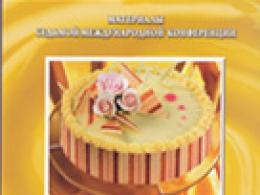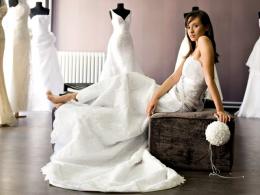Sewing a straight skirt. Modeling of a skirt with reliefs. Skirt sewing technology Pencil skirt pattern with embossed seams
After all the constructions, we cut the front panel along the relief line (dashed line).
To build a pattern of a straight skirt with slots, one should not forget about the allowances for the slots. These are rectangles 6-7 cm wide and 20-25 cm high with a skirt length of 50-60 cm. We add them to the relief lines of both parts of the front panel (Fig. 4).
Layout on the fabric of a pattern of a classic skirt with reliefs
The layout of a skirt pattern with reliefs on the fabric, and hence the fabric consumption, depends mainly on the width of the fabric, and, of course, on the size of the pattern itself.
Consider two options that differ in the size of the pattern. The width of the fabric in both cases is 140 cm, the length of the skirt is 58 cm, the fabric consumption is 75 cm.
1 option- for hips of 100 cm or less. Fig.4.
Option 2- for the volume of the hips 100 - 110 cm - fig.5.
With an increase in the volume of the hips, the width of the fabric may not be enough, so we do the layout in an economical way, with a turn of the central front part.
In option 2, the parts are laid out in different directions, so you need to use fabrics without a directional pattern and pile.
With a fabric width of 150 cm, the same layout will work for a hip volume of up to 120 cm.
Tailoring of a straight skirt with reliefs
We begin work with relief seams.
In order to qualitatively sew a straight skirt with slots, it is important to properly process the slots. Here you will find a photo with explanations:.
When the front panel is assembled together, then - the usual sequence for sewing a straight skirt:
- we grind tucks, side and back middle (if any) seams;
- we sew a zipper;
- we process the top of the skirt with a belt;
- sewing the bottom of the skirt:
This skirt can be made without slits in front. You can replace them with one cut in the left relief seam - then the allowances for the slots are not needed.
The back panel can also be made with reliefs. The construction of the relief line at the back is similar to the construction at the front.
One more moment. In the photo above, the reliefs are located far from each other. This is because the size 48 mannequin is wearing a larger skirt. Therefore, the distance between the reliefs seems disproportionately wide. According to the above calculation method, the reliefs will be in their place for each size.
Waist 66cm, hips 90cm.
There is a classic, you can not argue with it. We will not argue, we use it for our own selfish purposes. Pencil skirt! We take a standard, draw reliefs, add piping, lace, tucks, or use layering, such as guipure and chiffon, and we already get something very similar to romantic style. And the fantasy has no end! And we are so beautiful, different and happy!
Today we offer you finished pattern.
If you want build your own pattern skirts for a specific figure, you can use our step by step instructions.
Modeling a pencil skirt described in several ways previously.
If you are the owner of a standard figure, then this READY pattern is for you!
IS FREEREADY PATTERN pencil skirt with two reliefs on the front panel. On the back panel there is a middle seam into which a zipper is sewn. In the same seam at the bottom of the skirt, there can be a slit, slot, pleat or frill. We deliberately do not mark any marks on the pattern of the back panel and do not give any allowances, leaving the choice to you. Allow for processing according to your decision.
Pattern sizes:
waist circumference 62cm,
hip circumference 86cm,
skirt length 68cm.
The pattern is given WITHOUT seam allowances!
Preparing a pattern for work is extremely simple.
Click on the diagram at the end of the article and skirt pattern will open in a new window.
Print the pattern sheets on the printer, connect them according to the diagram and cut them out.
Be sure to check the scale. On a printed sheet with a depicted square of 10x10 cm, the sides of 10 cm should correspond to exactly 10 centimeters.
Compare the sizes of the patterns with your measurements. Make changes if necessary.
After that, start cutting. Do not forget give seam allowances and additional allowances in those places where clarifications are possible during fitting.
Having swept away the details, try on the skirt, make any necessary adjustments and start sewing.
You can change the finished pattern if you wish, in accordance with your preferences. For example, change the configuration of the reliefs, add pockets, flaps, belts, buckles or other decorative elements. You can also adjust the length and width of the skirt at the bottom.
The upper section of the skirt can be processed in various ways, for example, facing, inlay, belt of various heights, etc.
I draw your attention to the following: if you are sewing a skirt from elastic fabric, then it is desirable to process the upper cut with elastic material. For example, sew an elastic band or lace with a scalloped edge, if this does not contradict the style, or process it with a piping (belt) from the same fabric as the skirt itself.
In the following articles, we will continue this tenacious topic and try not to ignore women of different builds.
If you have any difficulties with printing patterns, write and we will post a master class with the details of this process.
The ability to model allows you to sew several completely different skirts using one pattern option. If you like to dance, then patterns of gypsy and Spanish skirts will allow you to sew an outfit for performances yourself. And if you just follow fashion, or prefer your own, purely individual style, then this section will help you always look fashionable and stylish. Moreover, using this skill, you can sew an exclusive dress. There are many styles of skirts: godet, flared, sun, pleated, pleated, Scottish, spiral, mini, midi, maxi, and skirt patterns will allow you to fulfill any fashion fantasies. Below are very interesting and practical options for skirt patterns: patterns of straight skirts, patterns of skirts "Gode", patterns of skirts "Sun", patterns of straight skirts with a detachable cape, patterns of wrap skirts, patterns of skirts with a frill frill, patterns of skirts with undercut and drapery etc. which are easy to sew and pleasant to wear.
Taking measurements
In mass sewing, to build drawings of patterns, ready-made tables are used, in which the measurements of the necessary parameters of typical figures are entered. For individual tailoring, the use of such tables is impractical, since more accurate and detailed data are required: Another system is used here - calculation and measurement, which is based on measuring the distances between certain points human body. These distances are called measurements.
To take measurements, you must have a centimeter tape, a pencil and a note book. In this case, certain requirements must be observed: the person from whom measurements are taken must stand relaxed, with a straight posture and arms lowered along the body; the legs should be brought together at the heels, and the socks turned slightly outward (with the slightest deviation to the sides, the measurements may turn out to be inaccurate); when measuring measurements, the centimeter tape must not be tightened or, conversely, loosened; in order to eliminate the distortion of readings, it is advisable to take measurements on linen.
Remember! The accuracy of the drawing of the pattern depends on the correctness and accuracy of the measurements taken by you and, therefore, appearance the item you have made.
However, that's not all.
to build a drawing of a skirt, you need to consider which type of physique your figure belongs to. If you have a standard folded figure (smoothly wavy back, the location of the protruding points of the shoulder blades and buttocks at the same level relative to the vertical, moderate notch at the waist and protrusion of the buttocks, normal hip width), then the following measurements are needed to build a skirt drawing
Straight two-seam skirt
 Despite the variety of this or that skirt, a straight two-seam skirt is the basis for building many models. This skirt perfectly exists as an independent product and as an integral part of many costumes. After all, it is not for nothing that she is one of the classic models and therefore has rightfully been at the peak of fashion for several decades now. It is suitable for women of any age category, and will also be appropriate both for special occasions and for everyday wear. This skirt can be sewn from almost any type of fabric. However, it is not recommended to sew it from fabrics in a cage, since fitting such a pattern is a significant difficulty. If you decide to sew a skirt made of striped fabric, then when cutting it is necessary to observe the symmetry of the pattern on the front and back panels. A straight two-seam skirt without expansion along the bottom will look a little narrower. Therefore, it is not recommended to wear it to women with low hips.
Despite the variety of this or that skirt, a straight two-seam skirt is the basis for building many models. This skirt perfectly exists as an independent product and as an integral part of many costumes. After all, it is not for nothing that she is one of the classic models and therefore has rightfully been at the peak of fashion for several decades now. It is suitable for women of any age category, and will also be appropriate both for special occasions and for everyday wear. This skirt can be sewn from almost any type of fabric. However, it is not recommended to sew it from fabrics in a cage, since fitting such a pattern is a significant difficulty. If you decide to sew a skirt made of striped fabric, then when cutting it is necessary to observe the symmetry of the pattern on the front and back panels. A straight two-seam skirt without expansion along the bottom will look a little narrower. Therefore, it is not recommended to wear it to women with low hips.
CONSTRUCTION OF A DESIGN DRAWING OF A STRAIGHT TWO-SEAM SKIRT
To build a drawing (Fig. 14), the following measurements of the figure are required: semi-waist circumference (St), floor at hip circumference (C6) and product length (Dsh) - And you also need to know the amount of the allowance for loose fit along the waist line (Pt) hips (P6). For all sizes they are equal:
Fri = 0.7-1.0 cm, Pb = 1.5-2.0 cm.
In the future, the necessary measurements and increments will be called "initial data".
For the convenience of construction and calculations, we take measurements of a typical figure; St = 38 cm, Se = 52 cm, Dt = 75 cm.
We build a right angle with the vertex at point T. The segment TN corresponds to the length of the skirt and is the middle of the front panel. The segment TB determines the position of the line of the hips and is equal to 13.5-19.5 cm. Through the obtained points B and H, we draw lines perpendicular to the straight line TN. From point B along the line of the hips, we set aside a segment equal to the measurement of the half-girth of the hips (C6) plus an increase in the free fit on the hips (Pb), and set point B1
BB 1 \u003d C6 + Pb \u003d 52 + 2 \u003d 54 cm.
Draw a vertical line through point B 1 until it intersects with the waist line at point T1 and the bottom line at point H1. This straight line is the middle of the back panel. From point B to the right along the line of the hips, set aside BB2
BB 2 = BB1 / 2 - 1 = TT2 = HH2
Draw a vertical line through point B 2 until it intersects with the waist line at point T2 and the bottom line at point H2.
I think you will be interested:
>Pattern of a fashionable pencil skirt with a one-piece belt and original figured reliefs. At the bottom of the middle seam of the back panel of the skirt there is a slit that provides freedom when walking. The zipper can be located both in the left and in the middle seams.
You can use a variety of fabrics to make skirts. A classic suiting fabric, one-colored and patterned, or a combination of both, is suitable. You can also use raincoat fabric, jeans, corduroy, taffeta and other fabrics. Depending on the fabric and finishes, such as topstitching or set-in piping along the raised seams, this skirt model can be made in both a sporty and classic style. In any case, it is a modern, feminine, original skirt model.
Pattern preparation: print on a regular printer, glue the sheets according to the pattern (it is printed on the first sheet), cut out the size that suits you. That's all, you can start cutting.
Pattern is given full size without seam allowances on a conventional figure. If your parameters do not fit into generally accepted standards, adjust the pattern in accordance with the features of your figure. And also when cutting, make allowances for seams a little more than usual, especially in those places where clarifications are possible when trying on.
The fabric will need approximately 0.80 m with a width of 1.50.
The upper section of the skirt is processed with a facing.
Open skirts
- The middle part of the front panel of the skirt 1 piece
- The upper side part of the front panel of the skirt 2 parts
- The lower side part of the front panel of the skirt 2 parts
- The middle part of the back panel of the skirt 2 parts
- The upper side part of the rear panel of the skirt 2 parts
- The lower side part of the rear panel of the skirt 2 parts
- Facing the front panel of the skirt 1 piece
- Facing the back panel of the skirt 1 piece
Skirt tailoring
After sewing, overcast all sections and iron or iron them in accordance with the style of the product. Overcast the middle sections of the back panel before sewing
- Stitch the side parts together first, and then connect them to the middle part of the skirt. If you settled on a sporty version and selected the fabric accordingly (jeans, corduroy, raincoat fabric, etc.), lay a finishing stitch (single or double) along each relief.
- At the bottom of the middle seam of the back panel, process the cut.
- Now that the front and back panels are finished, join the side seams, leaving an open section in the left side seam for the zipper.
- Stitch in the zipper.
- Process the upper section of the skirt, having previously duplicated the facing of the front and back panels of the skirt with an adhesive pad.
- It remains to hem the bottom and the skirt is ready.
Hello, friends!
Today's publication is the answer to a question that I received not so long ago from a reader of the blog “You can't forbid beautiful sewing!”.
You have no idea how nice it is to know that my leadership brings benefits and tangible results, in the form of new products!
I am always happy when I receive such letters in which you share your victories, thank you!
I could not leave Nellie's request without attention.
The request is, and I quote:
"Hello, Elena!
I don't know if I can address you with a personal request. The fact is that the cold is coming and I would like to sew a warm skirt. But I have certain wishes. I want a pencil skirt with reliefs in front (a simpler relief is possible - two seams vertically in the middle of each leg), without a belt, just with a facing and a zipper at the back, with a lining and a slot. The length is slightly above the knee.
I bought suit fabric on fleece, laid it out and was confused.
Elena, if you can help, I will be very grateful. My size is 48 (if anything). I took a course from you on building the base of a pencil skirt, but I couldn’t model it myself. I have never sewed skirts with lining and vents. You have a very accessible form of explanation, I really liked it.
Thanks in advance."
In short, I already answered Nelly's question by mail so as not to delay creative process, but promised to tell more about this model.
Andso, today we will consider the modeling of a skirt with reliefs and the technology of sewing this skirt.

Of course, it is better to build your base, taking into account the characteristics of your figure, especially if it differs from generally accepted standards, but if you have a proven finished pattern, it will work as well.
Modeling of a skirt with reliefs.
Modeling a similar skirt is easy.
To do this, on the basis of a straight skirt, you need to draw a line parallel to the middle of the front panel from the end of the tuck (if you need reliefs on the back panel, draw a line parallel to the middle of the back panel, respectively).

Sign the details, mark the shared thread and cut the patterns along the marked lines.

The technology of sewing a skirt with reliefs.

Skirt lining. Stages of cutting and processing.
If the skirt is lined:
The lining should be cut according to the cut details of the skirt, keeping all the decorative and constructive lines of the cut.
Before basting on the sides, for a better fit of the skirt due to the side allowances, be sure to cut off 0.2 cm on both sides, leaving the width of the allowances for the seams, but reducing the lining along the hips, and therefore in general for the manufactured product.
If the style of the skirt is without structural and decorative elements, sewing on the lining is easy:
Stitch the darts and side cuts, leaving 16-18 cm unstitched for the fastener in the left side seam (or optional), hem the bottom of the skirt flush with the cut of the allowance for hemming the bottom of the product.
Combine the processed lining with the waistline, baste.
IMPORTANT: if the upper cut of the skirt is processed with a facing, then the lining is cut out minus the details of the facing. The podkald is stitched to the lower cuts of the facing.
In the clasp, stitch the lining for allowances. To make the lining less mobile, fasten on one side at the level of the hips along the allowances for the seams with the product.
In pleated skirts, position the seam of the lining over the pleat of the top and process the slit for a free step.
The darts and seams in the lining should be located strictly above the darts and seams of the top of the skirt.
Processing the lining in a skirt with a vent.
If the skirt has a vent, the lining of the lower part of the vent must be folded inward and sewn with blind stitches for the allowance for processing the top.
On the upper part of the lining, make a notch to the width of the allowance for the slots, from the corner - by 0.7 cm, bend the allowance inward and hem manually according to the allowance for processing the slots.
Along the upper edge of the lining with the top of the skirt, we will process the belt or facing.
I do not yet have a video on the topic of processing with a slot (you need to fix the situation), but I found an interesting and understandable video for you.
The teacher very competently and clearly explains to beginners the stages of processing slots.
The first part of the spline processing
The second part of the processing splines
The third part of the spline processing
Skirt ironing.
Skirts need to be ironed only on an ironing board, electric, with an iron with a thermostat through an iron.
First you need to carefully iron, iron or iron all seams, darts, folds, pockets, and then the entire skirt completely through the ironing from the wrong side.
We fix the ironed product on a hanger, leave it to dry completely and fix the shape given to the product (skirts made of woolen fabrics - 20-25 minutes, skirts made of silk and cotton fabrics - 10-15 minutes).
Iron the side seams of the skirts on a special pillow oval shape(can be replaced with a towel folded several times) to avoid deformation of the side lines.
When ironing the bottom hemming, it is better to place a double-folded fabric to the edge of it and slide the iron over the hemming and the underlying fabric through the moistened iron so that the edge of the seam is not printed on the front side.
Fix the ironed product on a hanger, leave it to dry completely and fix the shape given to the product (skirts made of woolen fabrics - 20-25 minutes, skirts made of silk and cotton fabrics - 10-15 minutes).
We iron all finished products only in the shared direction of the thread, without stretching it.
So, we have considered the modeling and technology of sewing a skirt with reliefs, I hope now it will not be difficult for you to sew such a skirt.
- Recommendations for quality tailoring of things ...
- How to sew a skirt in the assembly on an elastic ...






